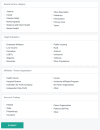Mobile health clinics in the United States
- PMID: 32197637
- PMCID: PMC7085168
- DOI: 10.1186/s12939-020-1135-7
Mobile health clinics in the United States
Abstract
Background: Mobile health clinics serve an important role in the health care system, providing care to some of the most vulnerable populations. Mobile Health Map is the only comprehensive database of mobile clinics in the United States. Members of this collaborative research network and learning community supply information about their location, services, target populations, and costs. They also have access to tools to measure, improve, and communicate their impact.
Methods: We analyzed data from 811 clinics that participated in Mobile Health Map between 2007 and 2017 to describe the demographics of the clients these clinics serve, the services they provide, and mobile clinics' affiliated institutions and funding sources.
Results: Mobile clinics provide a median number of 3491 visits annually. More than half of their clients are women (55%) and racial/ethnic minorities (59%). Of the 146 clinics that reported insurance data, 41% of clients were uninsured while 44% had some form of public insurance. The most common service models were primary care (41%) and prevention (47%). With regards to organizational affiliations, they vary from independent (33%) to university affiliated (24%), while some (29%) are part of a hospital or health care system. Most mobile clinics receive some financial support from philanthropy (52%), while slightly less than half (45%) receive federal funds.
Conclusion: Mobile health care delivery is an innovative model of health services delivery that provides a wide variety of services to vulnerable populations. The clinics vary in service mix, patient demographics, and relationships with the fixed health system. Although access to care has increased in recent years through the Affordable Care Act, barriers continue to persist, particularly among populations living in resource-limited areas. Mobile clinics can improve access by serving as a vital link between the community and clinical facilities. Additional work is needed to advance availability of this important resource.
Keywords: Health care access; Health disparities; Mobile clinics; Mobile health unit; Population health; Social determinants of health.
Conflict of interest statement
The author(s) declare(s) that they have no competing interests.
Figures






References
Publication types
MeSH terms
LinkOut - more resources
Full Text Sources

